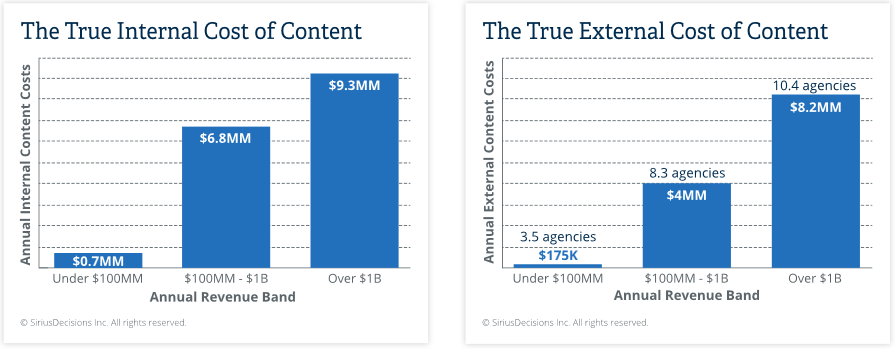B2B Content Curation Costs & How to Maximize its ROI
When you don't know if what you are creating is working, how would you know if it is worthwhile to continue? Unfortunately, the cost associated with content and content marketing is one of the most common struggles for many businesses. Earlier this year, after surveying 291 B2B organizations, a study by the research firm SiriusDecisions’ found that the majority of B2B content creation investment is executed internally, which means that most content creation costs are hidden. To be exact, enterprise organizations generate 53% of their own content, and emerging companies create a whopping 83% of content in-house. Good to know but what should I care, you may ask? The problem with content creation is that 65% of content is unused mostly because the content is not findable or relevant. This article discusses the cost of B2B content curation as well as how to calculate and maximize content ROI.
to continue? Unfortunately, the cost associated with content and content marketing is one of the most common struggles for many businesses. Earlier this year, after surveying 291 B2B organizations, a study by the research firm SiriusDecisions’ found that the majority of B2B content creation investment is executed internally, which means that most content creation costs are hidden. To be exact, enterprise organizations generate 53% of their own content, and emerging companies create a whopping 83% of content in-house. Good to know but what should I care, you may ask? The problem with content creation is that 65% of content is unused mostly because the content is not findable or relevant. This article discusses the cost of B2B content curation as well as how to calculate and maximize content ROI.
The Cost of B2B Content Curation
Although it is extremely hard to separate the cost of content creation from the overall marketing costs, SiriusDecisions used a special method with its study and found:

The results above demonstrate that average internal costs for B2B content creation are significantly higher than external costs. Another interesting finding is that enterprise organizations spend two times more than they think they do on content, and emerging growth organizations spend more than ten times. To be exact, the total content creation investment for enterprise organizations, which generate over $1 billion in revenue, averages $17.5 million primarily spent on blog posts, emails, brochures, ads, Web pages and infographics. You can also find the total content creation investment for emerging growth organizations and mid-size organizations in the chart below:

Calculating the cost of content creation is relatively simple for those who outsource their content creation and management, as it is an explicit cost that shows up on vendor invoices, but internally created content, which represents the majority of content creation investment for organizations of all sizes, is harder to sort out as employees may wear multiple hats and get involved in the creation process. In fact, SiriusDecisions found that product managers who command a relatively high salary and constitute a large function, spend 45 percent of their time creating content. Interestingly, they represent almost 40 percent of the content-creating headcount within B2B organizations. Second on the cost list is field marketing, representing 18 percent of overall internal costs, followed by portfolio marketing with 15 percent, marketing communications with 5 percent, and corporate communications with 4 percent - combined, these five functions represent 89 percent of internal content creation costs.
How to Calculate Content ROI
When it comes to calculating your business’ content cost, though, Contently has a fairly simple method, based on common sense. Here is an example of how Contently used this method to determine the ROI for acquiring one particular client:
-
First contact: Prospect reads 2 Contently blog posts. Cost for writing posts: $700
-
More touchpoints: Prospect reads 2 more blog posts. Those two articles cost another $700, bringing the tab up to $1,400.
-
Down the funnel: Prospect fills out a lead form, and from there, reads 2 case studies on the Contently website. These two study cases cost: $900
-
The prospect makes a call with sales team but this is calculated into the ROI for sales, instead of content.
-
Final Push: Sales team directs prospect to a piece of content to help dispel her concerns about partnering with a vendor rather than keeping content creation in house. The cost for content: $350
-
Happy ending: Prospect is now a current client. The sales process is complete. The total value of the contract is $82,000. Since the company decided to attribute 50 percent of the revenue to content and 50 percent to sales, since the first touchpoint came from an article, total revenue from the contract is $41,000.
As a result, Contently generated $41,000 as total revenue from content and spent $2,650 on the content involved in this cycle.
Although it wouldn’t work that well for those who are looking for a more sophisticated way of calculating content ROI, I found the logic behind this very applicable for many businesses thus it will get you pretty close to an accurate value.
For the content marketing campaign, there’s is another simple tool that you can utilize if you are able to gather data on the total cost of a campaign, website traffic garnered, and the number of social shares, links, and media replacement as the tool, called Fractl’s Content ROI Calculator, requires you to assign the estimated dollar value of each field.
How to Maximize Content ROI
Gleanster Research and Kapost surveyed over 3,400 marketers from organizations of various sizes to quantify the performance of their B2B content marketing initiatives. One of the key findings showed that mid-to-large B2B organizations lose an estimated $958 million each year because their content marketing has gone wrong. You might think that the lack of investment should be causing this but conversely, 67 percent of respondents ranked content marketing as a top three priority. The underlying reason is not the insufficient awareness. The challenge is that how they manage the overall content process results in inefficiency. This information is backed up by the other research, B2B Content Marketing 2017 Benchmarks, Budgets, and Trends—North America, conducted by the Content Marketing Institute. The study found that while 89% of B2B marketers are using content marketing, and 52% of the nonusers are planning to start using it within 12 months, only a bit more than half of the marketers include well-defined business goals for content in their strategy.
I could throw a whole lot more of the key findings and such your way but you get the idea. So obviously the equation goes:
Content revenue – content cost = content ROI
Therefore, I would like to divide this title into two subtitles:
How to Maximize Content Revenue
Target your audience with laser-precision: Keywords are still powerful as they provide marketers shorter, more precise phrases to work with, more trackable results, and generally higher potential volume. To cut through the noise, niche keywords should be a forethought, not an afterthought when content is curated. Although it requires a little bit of research and a deep understanding of your target audience, once it is documented, it can go a long way and ultimately, contribute to revenue generation.
Don’t be shy to repurpose your content: There are so many reasons and ways to utilize content over and over again. Rethink, reimagine, repurpose, and reuse whenever it is applicable. I mean we just discussed the cost of content creation so seizing every opportunity to maximize the output is critical for efficiency.
Allocate your resources to favor quality over quantity: This is a very obvious one in theory but you would be surprised by how many businesses are actually failing on this one in the real life as it is easy to get caught up in the trend of continuously posting stuff.
Remove the burden of search for sales: Without an easy way to find the resources they need, sellers end up spending 30% of their time creating content themselves. This is wrong on so many levels. Organizations should rest assured that the content that content creators are spending time and money on creating, are getting put to use and sales people's use of time isn't on searching and curating content when they’re supposed to be focused on closing the deals.
How to minimize the content cost
Choose the best way of content curation: Do a thorough research on provider alternatives. While a full-time team of in-house content creators works best for some organizations, a content agency or a freelancer may reduce the cost for the others. It is always beneficial to know the cost of every option so you can see the big picture.
IT and marketing automation reduces cost: Automation can save a good deal of time when it is used wisely. However, it is also quite important to map out which tasks within the organization can be automated and which tasks can’t be, as the only thing worse than not automating is trying to automate too much. There are a plethora of tools that content creators can use to spread the word so they can focus more on content creation. The good news is, many of these tools offer trial runs for free or minimal investment. Buffer, for instance, schedules social sharing with a content calendar and offers plug-ins to curate content from anywhere on the web. It is free with limited features; $10/month for one user; $50-$250/month for larger businesses. Or Hootsuite offers pretty much the same features, plus integrates with a few other social channels and also offers basic social listening capabilities. It is also free with limited features; $10/month up to 9 users; deeper analytics capabilities are available at an extra cost; its pricing for an enterprise solution requires contact with them.
Strip away the platforms you don’t use: Stop promoting your content on every medium you can think of because it won’t work and you’re wasting your time. Focusing on the channels that send you the most visitors will definitely reduce the cost and save your time, effort, and money.
The bottom line is that the proper course of action is to make content easier to find and use, and to increase its quality and relevance to target audiences. While you are doing so you need to follow a documented content strategy. However, to understand if your strategy is working or not, you need to find out your content ROI, which depends on your content cost and the revenue that your content generates. With all this knowledge, ultimately, your organization will give your audience content they won’t get anywhere else.

Venus Tamturk
Venus is the Media Reporter for CMS-Connected, with one of her tasks to write thorough articles by creating the most up-to-date and engaging content using B2B digital marketing. She enjoys increasing brand equity and conversion through the strategic use of social media channels and integrated media marketing plans.